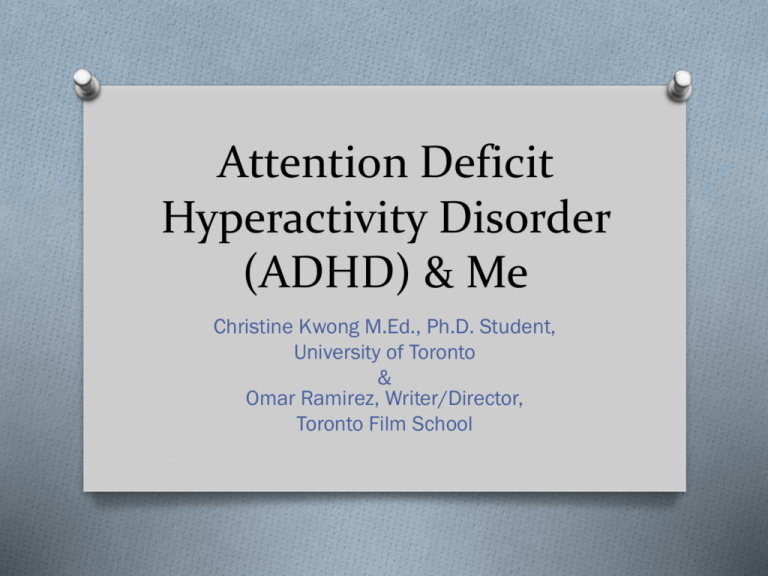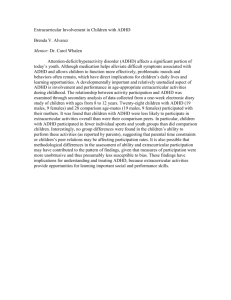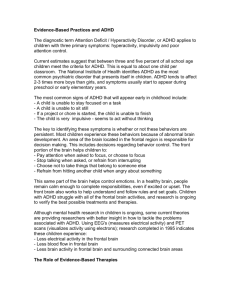Attention Deficit Hyperactivity Disorder (ADHD) & Me
advertisement

Attention Deficit Hyperactivity Disorder (ADHD) & Me Christine Kwong M.Ed., Ph.D. Student, University of Toronto & Omar Ramirez, Writer/Director, Toronto Film School ADHD &Me: Outline of Session: Learning Objectives 1. Understand issues related to stigma and ADHD 1. Enhance the knowledge of the role physical activity has in understanding ADHD 1. Enhance the knowledge of youth and adults in understanding what is meaningful and effective to individuals living with ADHD 1. Provide real-life strategies on how to succeed academically: what worked, what didn’t, and lessons learned. 1. To engage youth and adults in discussing the importance of knowing and providing support to those similar to themselves ADHD: What is it and why is it important? • What is it? • • • • • Why Focus on ADHD? • • • • Attention Deficit Hyperactivity Disorder (ADHD) one of the most prevalent childhood psychiatric disorders 3-7% of all school-aged children affected (American Psychiatric Association, 2000). a neurobehavioral disorder characterized by patterns of inattention and/or hyperactivity as well as poor impulse control (American Psychiatric Association, 2000). (American Psychiatric Association, 2000). Understudied population Until recently myth thought to disappear when one enters adolescence (Gadow & Weiss, 2001; Spencer, Biederman, Wilens, & Faraone, 1998). Now know ADHD dx. & sx. Continue into and through adulthood (Fargason & Ford, 1994; Hill & Schoener, 1996;). Why is it important? • • • Mental health and social well-being of those affected and their families and friends ADHD Usually accompanied by concurrent disorders such as anxiety and depression (Angold et al., 1998; Biederman et al., 1998; ) Social difficulties(Pelham, et al., 1990; Pelham, et al.,1998) 1. Stigma & ADHD ADHD is one of the most stigmatized of the psychological disorders (Chew, Jensen & Rosen, 2009). Attitudes towards ADHD Misperceptions & Unfavorable attitudes towards individuals with ADHD by parents ( ), teachers ( ), peers (Erhardt & Hinshaw, 1994; Hoza, et al., 1995,) and even themselves (Chew et al., 2009). Pelham et al., 1990 Dumas & Pelletier, 1990 ADHD individuals describe themselves more negatively than individuals without ADHD (Chew et al., 2009). 2. Physical Activity & ADHD • Physical Benefits: • 20 minutes of aerobic exercise can help an ADHD student focus (Etnier et al.,1997 ) • Emotional Benefits: • 3 + sports played related to lower internalizing symptoms (Kiluk, Weden & Culotta, 2009) • Social Benefits: • Sports participation can facilitate in increases in social status in youth with ADHD (Pelham et al., 1990; ;Hoza et al., 2005). 3.What is meaningful and effective in those with ADHD(Kwong & Ramirez, 2014) • Creative outlet • Variety • Room to grow and explore different activities • Sports • Friends • Encouraging coaches and mentors(Beyer et al., 2008). 4. Academic Success: Practical Real-Life Strategies (4a)What Worked (4b)What didn’t work (4c)Lessons Learned 4. Academic Success: Practical Real-Life Strategies (4a)What worked: Context: Reading and comprehending long text. Yellow = important info Green = Gaps in literature Pink = authors, special studies or acronymns 4. Academic Success: Practical Real-Life Strategies • (4b)What did work • • • • • • • Re: Productive space/Environment Clean desk. Nothing on desk except what needs to be completed or needed Background music Going to the library Re: ADHD Accommodations Extensions/More time on tests Contact your teacher and CC your disability counselor • What didn’t work • • • • • • Re: Unproductive Space/Environment Writing papers/studying in the company of friends or television show on (unless it is for background music Complete silence Re: ADHD Accommodations Not advocating for/utilizing accommodations Assuming your teachers know what you need 4. Academic Success: Practical Real-Life Strategies O (4c) Lessons Learned Re: Deadline fast approaching Engaging in procrastinating behaviors (e.g. checking unrelated email, texting on phone etc). Lessons Learned: 1. Break larger tasks into smaller ones 2. Turn off Wi-Fi/Internet 3. Turn off cell phone/Turn on silent. 4. Check emails or phone only after smaller tasks are completed or after a set time (e.g. 30 minutes). Results: Time not wasted; more productivity; increase chance of staying on task. 5. Discussion: If you have ADHD, why is it important to know others with ADHD? • ADHD individuals describe themselves more negatively than peers without ADHD (Chew et al., 2009). • Knowing & spending more time with someone else with ADHD is related to better overall attitudes towards individuals with ADHD and themselves • Allport (1954) Why did we make this documentary? • Only 5% of children with ADHD go on to receive a college degree (Goldstein & Ellison, 2002). • Important for individuals with ADHD to understand why it is important to connect with others like themselves for support Future directions: Future special series of this documentary can highlight the success (e.g. academic, creativity, sports, etc. )and the barriers overcome (e.g. mental health and/or addiction issues) of those with ADHD that leads the way to inspire students with ADHD to reach their full potential. References American Psychiatric Association (APA) (2000). Diagnositic and statistical manual of mental disorders (4th ed. Text rev.) Washington, DC: APA. Angold, A., Costello, E.J., Erkanli, A. (1999). Comorbidity. Journal of child psychology and Psychiatry,40, 5787. Allport, G. W. (1954). The nuatre of prejudice. Reading, MA: Addison-Wesley. Barkley, R.A., (2008). Success for the ADHD college student. The ADHD Report, 16(5), 1-5. Beyer, R., Flores, M.M., Vargas-Tonsing,T. (2008). Coaches' Attitudes Towards Youth Sport Participants with Attention Deficit Hyperactivity Disorder. International Journal of Sports Science and Coaching, 3(4), 555-563. Biederman, J., Monuteaux, M.C., Mick, E., Wilens, T.E., Fontanella, J.A., Poetzl, K.M., Kirk, T., Masse, J., & Faraone, S.V. (2006). Is cigarette smoking a gateway to alcohol and illicit drug use disorders?: A study of youths with and without attention deficit hyperactivity disorder. Biological Psychiatry, 59, 258-264 Biederman, J.,Mick, E., & Faraone, S.V. (1998). Depression in attention deficit hyperactivity disorder ADHD children: “True” depression or demoralization? Journal of Affective Disorders, 47, 113-122. Boschert, S. (2013). Helping college students with ADHD is a challenge. Clinical Psychiatry News, 41(1), 1011. Chew, B.L., Jensen, S.A., Rosen, L.A. (2009). College students’ attitudes toward their ADHD peers. Journal of Attention Disorders, 13(3), 271-276. Dumas, D., & Pelletier, R.L. (1999). A study of self-perception in hyperactive children. The American Journal of Maternal/Child Nursing, 24, 12-19. Erhardt, D., & Hinshaw, S.P. (1994). Initial sociometric impressions of attention deficit hyperactivity disorder and comparison boys: Predictions from social behaviours and from non-behavioural variables. Journal of Consulting and Clinical Psychology, 62, 833-842. Etnier, J.L., Salazar, W., Landers, D.M., Petruzzello, S.J., Han, M., Nowell, P., (1997). The influence of physical fitness and exercise upon cognitive functioning: a meta-analysis. Journal of Sport and Exercise Psychology,19, 249–277. Fargason, R. & Ford, C. (1994). Attention Deficit Hyperactivity Disorder in adults: Diagnosis, treatment and prognosis. Southern Medical Journal, 87, 302-309. Gadow, K.D., & Weiss, M. (2001). Attention Deficit Hyperactivity Disorder in adults: Beyond controversy. Archives of General Psychiatry, 58, 784-785. Goldstein, S & Ellisa, A. (2002). Clinician’s guide to adult ADHD. New York: Academic Press. Hill, J.C. &Schoener, E.P. (1996). Age-dependent decline of attention deficit hyperactivity disorder. American Journal of Psychaitry, 153, 1143-1146. Hoza, B., Mrug, S., Gerdes, A.C., HInshsaw, S.P., Bukowski, W.M., Gold, J.A., et al., (2005). What aspects of Peer relationships are impaired in children with ADHD? Journal of Consulting and Clinical Psychology, 73, 411-423. Kiluk, B.D., Wedenm S., Culotta, V.P. (2009). Sport participation and anxiety in children with ADHD. Journal of attention disorders, 12 (6), 499-506. Kwong, C (Executive Producer), & Ramirez, O (Writer/Director). (2014). ADHD & Me [Documentary]. Toronto: Ontario. Toronto Film School. Lufi, D, & Parish-Plass, J. (2011). Sport-based group therapy program for boys with ADHD or with other behavioural disorders. Child and family Behaviour Therapy, 33, 217-230. Pelham, W. E., Greiner, A. R., & Gnagy, E. M. (1998). Summer treatment program manual. Buffalo, NY:Comprehensive treatment for attention deficit disorders. Pelham, W. E., Harper, G. W., McBurnett, K., Milich, R., Thiele, C., Murphy D. A., et al., (1990). Methylphenidate and baseball playing in ADHD children: Who’s on first? Journal of consulting and clinical psychology, 58(1), 130-133. Spencer, T., Biederman, J., Wilens, T., & Faraone, S. (1998). Adults with attention deficit hyperactivity disorder: a controversial diagnosis. Journal of Clinical Psychology, 59, 59-68.









